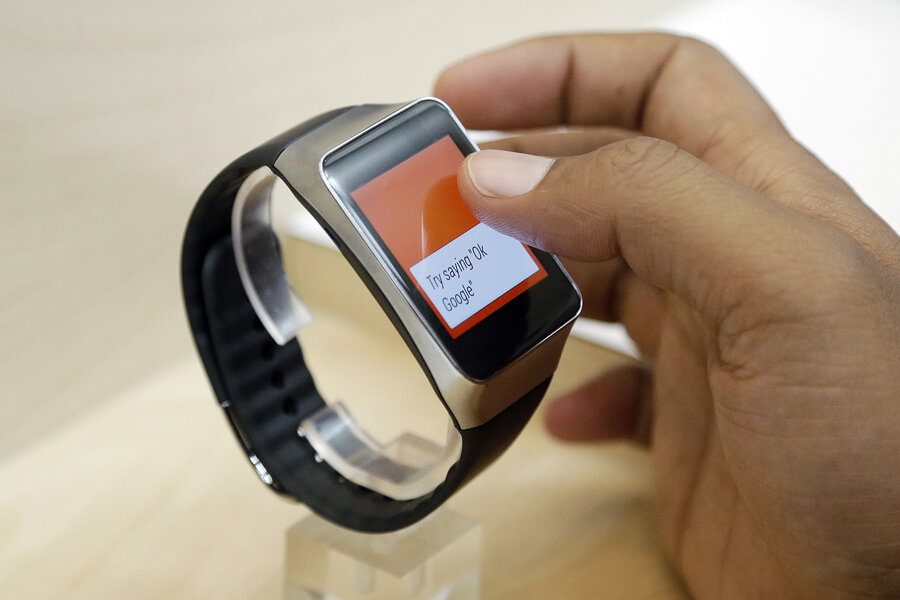LG G and Samsung Gear Live smart watches: What you need to know
For a brief while, Google Glass seemed poised to become the inevitable next step in smart devices. "It lets you do all the things you normally do with your smart phone, but it keeps you looking up," say proponents of the wearable technology. "It keeps you in the here and now." Granted, the technology could still catch on. But from getting banned in UK movie theaters to being mocked on The Daily Show, Glass hasn't quite yet proved the evolution in portable computing Google likely hoped it would be.
This doesn't mean people don't want an alternative to being totally dependent on their phones. It could be, however, that consumers are turning to something a bit less in-your-face: smart watches. Of course, it just so happens that Google is also the driving force behind this other type of wearable technology now consuming the gadget world.
The LG G Watch and the Samsung Gear Live are the two of the hot smart watches currently on the market. Both are powered by Google's Android Wear, on display at the Google I/O developer's conference in San Francisco last week. And both are appealing to customers in a subtler manner, the way Glass seems incapable of doing thus far – a downward glance at the wrist to check the time of your flight, a few spoken words to respond to a text. Oh, and there's also the price difference. While Glass sells for a steep $1500, the watches retail for around $200.
As Ron Amadeo noted recently in Ars Technica, "Google Glass is obsolete. Android Wear on a smart watch does nearly everything Glass can do and then some, and it comes in a package that is significantly more ergonomic, convenient, cheap, and socially acceptable. Android Wear has almost all the positives of Google Glass and none of the negatives."
To be sure, smart watches have garnered their own criticism and looks of disdain. Some, for example, have compared them to the outdated pop-culture accessories from TV shows like "The Jetsons" or "Star Trek."
Let's break down key similarities and differences between the two watches. What do they offer? What exactly do they do? And will they change the way users interact with their ever-growing number of devices?
The similarities
- Though one is made by Samsung and the other by LG, both watches function essentially as extensions of your smart phone in watch form. Notifications, for example, sent to your phone can appear on the watch's screen. In other words, imagine people asking their wrists for directions and you begin to get the idea.
- They both work on Google's Android operating system, have the same battery life, identical processors, the same amount of storage at 4 gisabytes, and the same amount of RAM at 512 MB. Android is well known to many smart phone users around the world, particularly Samsung's popular Galaxy line of smart phones. But, as was made clear at the I/O conference, Android is making a play to get on as many of your devices as possible, from the television to the car. As such, the watches come equipped with OK Google, the personal assistant that lets you do things such as search the web and send messages simply by speaking to the device.
- Both watches feature Google Fit, Android's fitness-tracking application. Because smart watches seem to have blended with fitness trackers, it feels only natural that these watches come equipped with sensors to let users monitor things such as their eating habits and workout regimen. However, only the Gear Live comes with a heart-rate monitor.
- Design-wise, both watches feature square faces.
The Differences
For all intents and purposes, the two watches are virtually identical. The main differences are primarily aesthetic. And yet, because these devices are fashion accessories, style matters. Here's a run-down on how the two watches differ:
- The LG G is a bit sleeker and being marketed a tad more on the high-end side. It is priced at $229.
- The Gear Live is marketed as "bright and stylish" and retails at $199.
- In terms of the physical make of the watches, the Gear Live has a screen size of 1.63 inches, while the LG G has a screen size of 1.65 inches. The Gear Live has a height of 2.2 inches and a width of 1.4 inches; the LG G has a height of 1.8 inches and a width of 1.4 inches. The Gear Live has a SuperAMOLED display, while the LG G has an IPS LCD display. And as for color, the Gear Live comes in Silver, while the LG G comes in "Black Titan" or "White Gold."
But we still may not be at the point where technology crosses the barrier into high fashion. A watch might not engender the eye rolls and squirms of paranoia that come with wearing a computer on your face. But it could still take some tinkering and redesigning before the smart watch makes the switch from super-cool digital watch to classy must-have accessory.
As Vanessa Friedman points out in The New York Times, while the watches perform well functionally, neither does much to make you rethink what a watch is and what it can do.
"They re-enforce all our old assumptions about the form, which is that you take your phone screen, make it small and stick it on your wrist. All I can think when I see them is: 'Beam me up, Scotty!' And where's the joy – or the desire – in that?"
And as David Pierce points out in The Verge, the benefits of having Android on his wrist are not enough to get him to trade in his current one. For him, no smart watch is as classy as its old-fashioned counterpart.
"I see the potential in Android Wear," he writes, "but I don't want to trade my watch for it. I want the best of both worlds – why can't I have all this useful information inside a device that I want to have on my wrist even when I'm not using it? I'd gladly pay $199, $229, or far more for a device I wanted to wear and be seen wearing that also happened to provide the Android Wear experience."
We may just need to wait a little longer before these wearable devices fully catch on in the mainstream. And soon, the current series of smart watches could have some company: Apple is rumored to be releasing an iWatch this fall.






